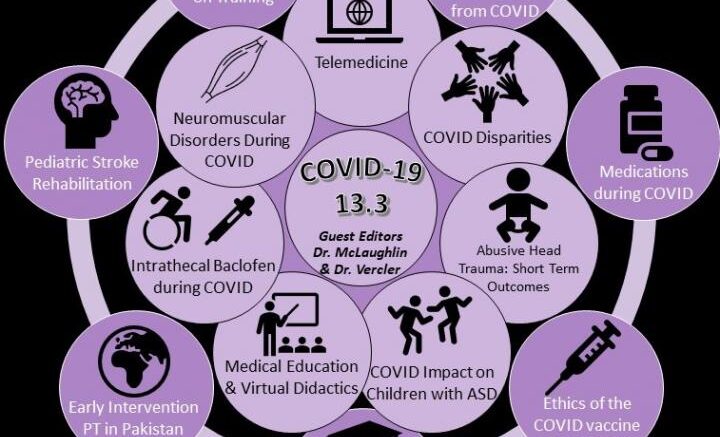Overview of topics covered in this special issue of the Journal of Pediatric Rehabilitation Medicine. Courtesy of Journal of Pediatric Rehabilitation Medicine
The impact of the COVID-19 pandemic on children with disabilities has not received much attention, perhaps because the disease disproportionately affects older individuals. In this special issue of the Journal of Pediatric Rehabilitation Medicine experts assess the impact of the pandemic on pediatric patients with special needs, their caregivers, and healthcare providers. They also focus on the growing importance of telemedicine and provide insights and recommendations for mitigating the impact of the virus in the short and long term.
"Pediatric rehabilitation patients frequently have more access and therapy needs. As clinics were put on pause or cancelled during the pandemic, some patients who may have needed care did not receive it in a timely manner. These children should be a focus of evaluation and intervention to mitigate the negative consequences of COVID-19 and the resulting containment strategies. The need for more ethical and conscious decisions in the treatment of persons from disabled populations should be recognized and included in future crisis planning," emphasize Guest Editors Matthew J. McLaughlin, MD, MS, Children's Mercy - Kansas City, Mo., and Christian J. Vercler, MD, C.S. Mott Children's Hospital, University of Michigan, Ann Arbor, Mich.
Children comprise approximately 2% of cases of COVID-19 in the United States. In most cases the child is either asymptomatic or has mild symptoms. However, children with disabilities like cerebral palsy (CP) are more vulnerable and are at higher risk for respiratory complications. Some can present with multisystem inflammatory syndrome (MIS-C) and need supportive care.
This special issue addresses many aspects of COVID-19 in vulnerable children with special needs, including spasticity management, autism spectrum disorders, CP, neuromuscular disorders, tracheostomies, MIS-C, schooling, and how to deliver medicines safely and effectively. It also considers the impact of the pandemic on healthcare providers in training including the need for disability-conscious medical education, training, and practice; the disparate influence of the pandemic on Black, Latinx, and Native American marginalized populations; as well as the telemedicine experience and role of virtual education.
There is concern that the virus could have a disparate impact on children with disabilities when viewed through the lens of race and equity. In the US, early data reported from multiple jurisdictions showed that there is a disproportionate impact of COVID-19 when measuring death rates and infection rates in Black, Native American, and Latinx individuals compared with White populations in multiple areas of the country. The risk of children with disabilities contracting coronavirus is directly related to caregivers and/or family members that share their living arrangements, explains Maurice G. Sholas, MD, PhD, Principal and Pediatric Physiatrist, Sholas Medical Consulting, LLC, New Orleans, LA, USA. He presents a number of measures to mitigate the problems, concluding that "Individual providers, health systems and policy interventions must be accountable and active to ensure that marginalized communities do not continue to be disproportionately impacted."
Patients with pre-existing respiratory disorders such as CP are at greater risk for respiratory complications if they contract COVID-19, notes Joline E. Brandenburg, MD, Department of Physical Medicine and Rehabilitation, and Department of Pediatric and Adolescent Medicine, Mayo Clinic, Rochester, Minn., and colleagues in a review of research on respiratory function and diaphragm muscle force generation in children with CP. They compare and integrate clinical work and basic science research investigating phrenic motor neuron and diaphragm motor unit dysfunction in an animal model and discuss the potential for individuals with CP to experience severe respiratory symptoms from COVID-19.
"We need to be vigilant in encouraging and supporting families of children with CP and individuals who have CP to practice physical distancing, good hand hygiene, minimizing trips to public places such as stores and restaurants, and thorough cleaning of any equipment that is used outside the home (i.e., walkers and wheelchairs) in order to reduce the risk of contracting COVID-19," advises Brandenburg.
COVID-19 has accelerated the adoption of telehealth across many medical specialties and is a special focus of this issue. "There has been an expansion of telemedicine offerings by many different pediatric rehabilitation providers," explain McLaughlin and Vercler. "Historically, pediatric rehabilitation patients are more difficult to transport, may come from a more challenged socioeconomic background, and have more medical co-morbidities than the general pediatric population. By more clinics offering telemedicine appointments, this may limit exposures to COVID-19 and decrease the caregiver burden if medical care can be provided within the home setting."
A survey of pediatric physiatrists by Anton Dietzen, MD, DC, Marianjoy Rehabilitation Hospital, Northwestern Medicine, Lombard, Ill., and colleagues, showed a significant increase in telehealth utilization since COVID-19, from less than 15% to 97%. More than 80% of respondents reported feeling comfortable using telehealth, 77% felt confident in the quality of the care provided, and 91% believed patients were satisfied with telehealth visits.
"Responses indicate that telehealth is expected to play a role in future pediatric physiatry and interest in telehealth continuing medical education is prevalent. Most pediatric physiatrists plan to continue or expand telehealth offerings after COVID-19," notes Dietzen.
The Guest Editors add that "the benefit of telemedicine and its expanded use may continue to benefit patients with rehabilitation needs, although we need to be aware that procedures such as intrathecal baclofen refills or botulinum toxin injections will require in person visits."
"Through this issue of the Journal of Pediatric Rehabilitation Medicine we are disseminating a wealth of information on COVID-19 and the effect that it has on our pediatric rehabilitation caregivers, providers and those with special needs," comments editor-in-chief Elaine L. Pico, MD, FAAP, FAAPM&R, UCSF Benioff Children's Hospital, Oakland, Calif. "It is my belief that this type of worldwide outreach and exchange of information is an essential part of the global solution to help mitigate the spread of this deadly virus.
Source: IOS Press

Be the first to comment on "Impact of COVID-19 on Children With Disabilities, Caregivers and Healthcare Providers"